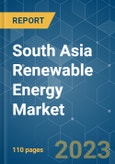The South Asia Renewable Energy Market is expected to register a CAGR of over 12% during the forecast period.
COVID-19 negatively impacted the market in 2020. Presently the market is likely to reach pre-pandemic levels.
This product will be delivered within 2 business days.
COVID-19 negatively impacted the market in 2020. Presently the market is likely to reach pre-pandemic levels.
Key Highlights
- Over the medium term, increasing investments and ambitious renewable energy targets are expected to drive the market's growth.
- On the other hand, increasing penetration of natural gas for power generation is expected to hamper the growth of the South Asia renewable energy market during the forecast period.
- South Asian developing countries are looking into inexhaustible and repeatable alternative energy sources such as solar, wind, hydro, and others are likely to create lucrative growth opportunities for the South Asia renewable energy market in the forecast period.
- India is expected to dominate the market and will likely witness the highest CAGR during the forecast period. This growth is attributed to the increasing investments, coupled with supportive government policies in the country.
South Asia Renewable Energy Market Trends
Solar Energy is Expected to Witness Significant Growth
- The solar energy segment is expected to witness significant growth in the South Asia Renewable Energy Market in 2021 and will continue significantly over the coming years. Most of the demand is likely from India, the world's prominent producer of solar energy.
- Commercial and industrial customers have driven the growth of solar energy in the region. Factors such as the decline in the Levelized Cost of Electricity (LCOE) for rooftop solar and favorable policies and corporate social responsibility programs are expected to drive the solar energy market in the region during the forecast period.
- In 2021, in South Asia, India added about 49,684 MW of solar energy, and Pakistan had an installed solar capacity of 1,083 MW, showing a considerable growth rate. South Asia countries are focused on installing solar rooftop systems to achieve their ambitious solar PV targets.
- India's solar potential is more than 750 GW, and the country's energy security scenario 2047 shows a possibility of achieving around 479 GW of solar PV installed capacity by 2047. Solar power in India, bestowed with high solar irradiance, has already achieved grid parity that encourages the adoption of solar power as a mainstream energy source, pushing forward the capacity installations in the utility-scale and rooftop solar segments.
- In September 2022, the Pakistan government approved the National Solar Energy Initiative to produce 10,000 megawatts (MW) of electricity through solar energy projects in the following months. In the first phase, solar energy would be supplied to government buildings, tube wells operating on electricity and diesel, and domestic consumers with low consumption.
- Therefore, solar energy is expected to have significant growth in the market during the forecast period.
India is Expected to Dominate the Market
- South Asia is a stronghold of renewables deployment in the Asia-Pacific region. In India, the government’s efforts to put in place supportive policy conditions were a major factor contributing to the increase in the country’s renewable energy capacity to 147.1 GW in 2021.
- India’s renewable targets have been supported by fiscal instruments such as generation-based incentives, capital, and interest-direct public financing, viability gap funding, concessional finance, and fiscal incentives.
- In September 2021, the Indian government announced plans to provide Viability Gap Funding (VGF) or grants for offshore wind and storage projects. The new scheme will help carry out the renovation and modernization of substations. The government has set a target of adding 30 GW of offshore wind energy projects by 2030.
- In February 2022, the Indian government allocated an additional INR 19,500 crore to support solar PV module manufacturing under the Production Linked Incentive (PLI) scheme.
- The scheme has various provisions for supporting the set up of integrated manufacturing units of high-efficiency solar PV modules by offering PLI on sales of such solar PV modules. It aims at attaining the ambitious goal of 280 GW of installed solar capacity by 2030.
- India has plans to obtain 40% of installed power generation capacity from clean energy sources by 2030 and to reach 175 GW by 2022, including 100 GW solar, 60 GW wind, 10 GW bio-power, 5 GW small-scale hydro.
- The ongoing renewable energy projects financed by the World Bank, and ADB in India are of a count of 6 active projects with a total commitment of around USD 1398 million financed by World Bank and 39 active projects financed by ADB.
- Therefore, with the upcoming and ongoing renewable energy projects, India is expected to dominate in the market during the forecast period.
South Asia Renewable Energy Market Competitor Analysis
The South Asia Renewable Energy Market is fragmented in nature. Some of the major players in the market (not in particular order) include ReNew Power Limited, Greenko Group Plc, ACME Solar Holding Limited, Tata Power Solar Systems Ltd, and Suzlon Energy Ltd.Additional benefits of purchasing the report:
- The market estimate (ME) sheet in Excel format
- 3 months of analyst support
This product will be delivered within 2 business days.
Table of Contents
1 INTRODUCTION
4 MARKET OVERVIEW
5 MARKET SEGMENTATION & ANALYSIS
6 COMPETITIVE LANDSCAPE
Companies Mentioned (Partial List)
A selection of companies mentioned in this report includes, but is not limited to:
- ReNew Power Limited
- Sindicatum Renewable Energy India Private Limited
- Greenko Group Plc
- ACME Solar Holding Limited
- Tata Power Solar Systems Ltd
- Suzlon Energy Ltd
- Adani Green Energy Limited
- Regen Renewables (Pvt) Ltd
- Zularistan Ltd.
- Sembcorp Industries Limited
Methodology

LOADING...










